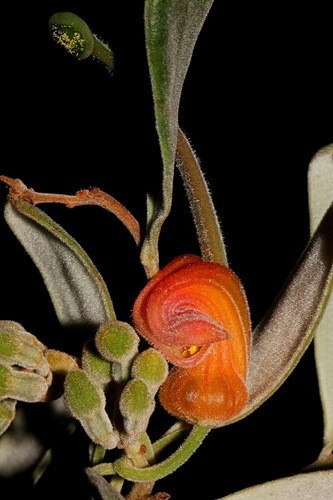Sand grevillea
(Grevillea arenaria)

Description
Grevillea arenaria, commonly known as sand grevillea or hoary grevillea,is a species of flowering plant in the family Proteaceae and is endemic to New South Wales. It is a spreading shrub with elliptic to egg-shaped leaves with the narrower end towards the base, and red, pink or orange flowers. Grevillea arenaria is an erect to spreading shrub that grows to a height of 0.3–4 m (1 ft 0 in – 13 ft 1 in). The leaves are elliptic to egg-shaped with the narrower end towards the base, 15–75 mm (0.59–2.95 in) long and 3–15 mm (0.12–0.59 in) wide with the edges turned down or rolled under. The flowers are arranged in groups of two to six on the ends of short side braches along a rachis 1–10 mm (0.039–0.394 in) long, and are red, pink or orange and hairy. The pistil is 24–32 mm (0.94–1.26 in) long and the ovary is sessile. Flowers are present in most months with a peak in spring. Grevillea arenaria was first formally described in 1810 by Robert Brown in Transactions of the Linnean Society of London from specimens collected near Port Jackson. Plants in the genus Grevillea are shrubs, rarely small trees with simple or compound leaves arranged alternately along the branchlets. The flowers are zygomorphic and typically arranged in pairs along a sometimes branched raceme at the ends of branchlets. The flowers are bisexual, usually with four tepals in a single whorl. There are four stamens and the gynoecium has a single carpel. The fruit is a thin-walled follicle that splits down only one side, releasing one or two seeds before the next growing season. The genus Grevillea was first formally described in 1809 by Joseph Knight from an unpublished manuscript by Robert Brown. Knight gave the spelling Grevillia, corrected by Brown in 1810 to Grevillea in Transactions of the Linnean Society of London. The genus was named in honour of Charles Francis Greville, an 18th-century patron of botany and co-founder of the Royal Horticultural Society. Grevilleas grow in most habitats, although few grow in alpine areas, in swamps or saline soils. Most species are endemic to Australia but three species grow in New Guinea, (G. papuana is endemic), three are endemic to New Caledonia and one species (G. elbertii) is endemic to Sulawesi in Indonesia
Taxonomic tree:







